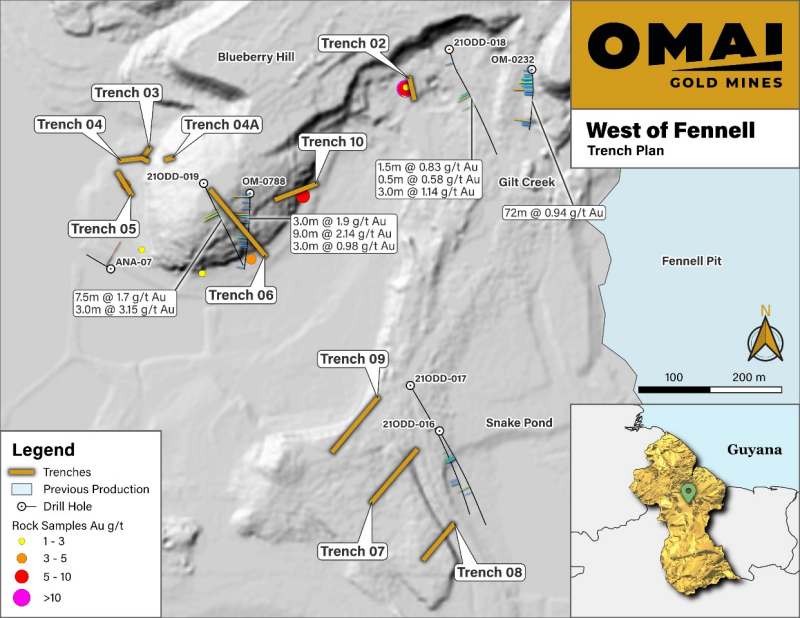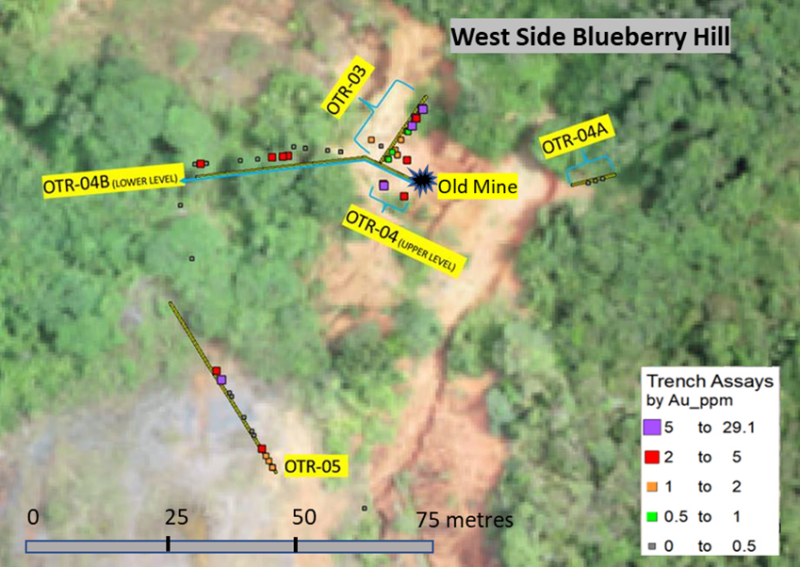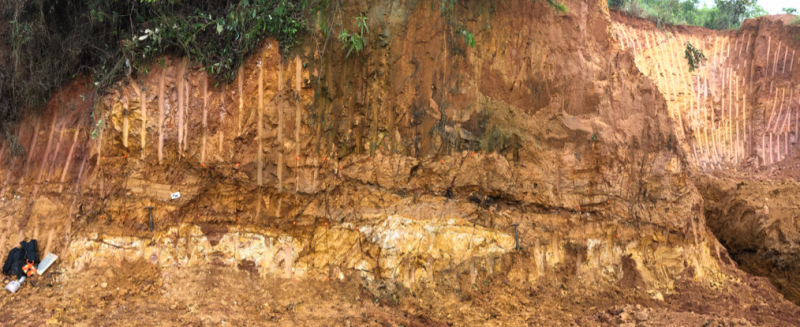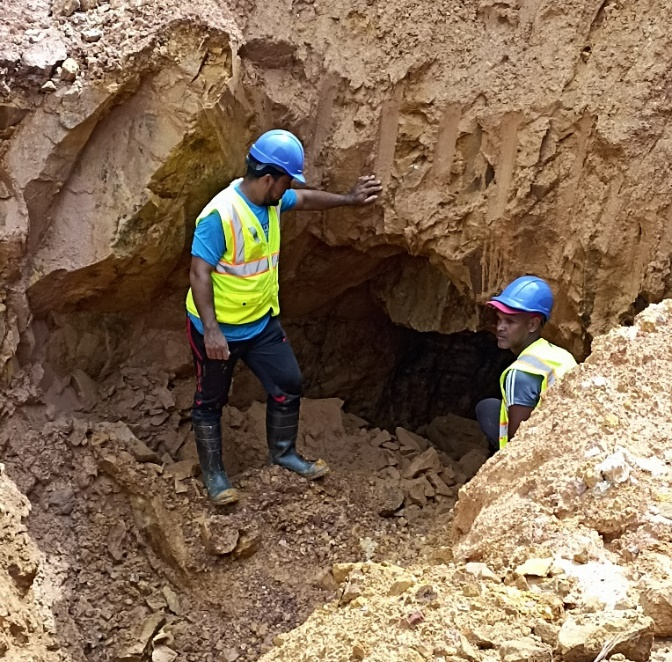




February 24, 2022 – TheNewswire - Toronto, Ontario - Omai Gold Mines Corp. (TSXV:OMG) (OTC:OMGGF) (“Omai” or the “Company”) is pleased to announce the first results from its trenching program that began mid-January, starting at the Blueberry Hill and Gilt Creek targets located west of the Fennell pit, on its Omai Gold Project in Guyana. Highlights of the trench samples to date include:
At Blueberry Hill, in trench OTR-03, fourteen (14) samples were collected with six (6) assaying between 1– 3 g/t Au, one assayed 8.35 g/t Au and three assayed over 15 g/t Au (including one grading 24.3 g/t Au);
Trench OTR-04 located further south along the same structure as OTR-03, had three samples over 3.5 g/t Au (one of which was 10.0 g/t Au) out of a total of 7 samples;
Trench OTR-05, also at Blueberry Hill, is lower on the hill and therefore represents a deeper level into the diorite. Fourteen (14) samples were taken, six (6) of which were between 1 to 3 g/t Au, and one sample assayed 11.5 g/t Au;
In trench OTR-02 in the Gilt Creek area, a total of eleven (11) samples were taken with all eleven assaying over 1.5 g/t Au, and half of them assaying over 6.0 g/t Au. Three of these samples assayed over 10 g/t Au with the highest sample of 21.3 g/t Au.
Trenching and sampling at Blueberry Hill and Gilt Creek identified several gold-rich, low-angle quartz-veined structural zones within both volcanic and diorite rocks. These structural zones are similar to those seen at the large past producing Fennell Mine, located only 500 metres to the east, where multiple stacked low-angle, gold-rich quartz veins were mined from the Omai quartz diorite stock (Figure 1). These new Blueberry Hill and Gilt Creek targets will be tested as part of the 3,000 metre drill program that is scheduled to begin later this week.
Elaine Ellingham, CEO commented, “These impressive trenching results when paired with our geologic mapping, have generated some exciting new exploration targets for the upcoming drill program. The Blueberry Hill – Gilt Creek trend has experienced limited historical exploration and these new results further highlight the potential for new discoveries in the immediate vicinity of the past producing pits.”
“Our success drilling Wenot in 2021 to a maiden Mineral Resource Estimate gives us a solid base from which to further build our gold resources on the Omai Property. We know there is ample potential to expand the Wenot resource both at depth and along strike. The current drill program will start by testing some of the new targets like Blueberry Hill, Gilt Creek, Snake Pond, Broccoli Hill and others, that provide opportunities for new near surface discoveries.”
Trenching Program:
Blueberry Hill, Gilt Creek and Snake Pond were identified among the priority exploration targets during the 2021 compilation program. Blueberry Hill corresponds to a very prominent magnetic low signature from the airborne geophysics, similar but even more pronounced than that seen over the past producing Fennell Mine. The magnetic low over Fennell is attributed to the quartz diorite stock, or plug, which hosts the multiple low-angle gold-rich quartz vein systems.
The exploration team conducted field work at Blueberry Hill in late November and identified a few outcroppings of diorite intrusive, some with quartz stockworks near the base of the hill, which was very encouraging. Several gold occurrences are known from historical rock sampling around the base of the hill, including 3.15 g/t Au on the west, 4.15 g/t Au on the south and 7.16 g/t Au and 3.23 g/t Au on the east. Last year, a single hole 21ODD-019, drilled by the Company in this area intersected 7.5 m of 1.7 g/t Au and 3.0 m of 3.15 g/t Au (Figure 1). This was collared about 70m from a 1997 drill hole OM-0788 that intersected 9.0 m of 2.14 g/t Au and 3.0 m of 1.9 g/t Au.
A total of 10 trenches have been completed to date in 2022, ranging in length from 15 to over 100 metres for a total of approximately 510 metres, with several assay results still pending. Trenching is conducted using a CAT 320 Excavator. Typical of the Guiana shield and the Omai property, a laterite layer is variably present, and a deeper saprolite layer is typical, and these overburden layers can limit where trenching and sampling is successful. All samples from the trenches were done by marking panels, or areas approximately 0.7 metres by 0.7 metres, being good representative samples. As a result of the thick saprolite, the rock is very soft and relatively easy to sample, typically carving out samples to a depth of approximately 5 cm. Particular attention and recording of the orientations of structures and of the quartz veining is critical to better understanding the mineralization and to determine the optimal orientation for follow up drilling.
Trenches OTR-03, OTR-04 and OTR-04A, OTR-04B and OTR-05 were completed on the western side of Blueberry Hill over the past several weeks (Figure 2).
Trench OTR-03 uncovered a near flat-lying contact between an andesitic volcanic unit above and a diorite below (Figure 3). Quartz veining within a number of structural zones is concentrated along and near this contact, with a dominance of flat to low-dipping orientations and a number of secondary vein sets. Early during this trenching, at a depth of about 2 metres, an old artisanal mine opening was encountered, driven into the side of the hill. This is an encouraging sign, evidence that a gold-bearing zone was being followed and mined (Figure 4). Trench OTR-04 exposed the extension of this same contact and structural zone further to the south.
Since the contact zone and the quartz veining are predominantly flat-lying or dipping at a low angle, it was not possible to expose or sample zones across significant widths. As a result, samples had to be collected predominantly along the strike of zones, which is not optimal for estimating the width of the zones. Combining the structure sampled across trenches OTR-03 and OTR-04, by 10 samples along a 20-metre strike, gives an average of 4.7 g/t Au across a 1.55 m width.
Trench OTR-04B further south along the same hill area, exposed mostly diorite. Of 22 samples taken, four assayed between 1 - 2 g/t Au and five were between 2 - 3.5 g/t Au. Trench OTR-04A, a short trench further up on the hill had only 3 samples taken with no significant gold values.
Trench OTR-06 is a long trench that started near the top of Blueberry Hill extending about 100 metres southeast, down to the base of the hill, almost parallel to the trace of hole 21ODD-019 that intersected gold in two intervals. Most of the trench exposed only laterite with abundant iron-oxide and was unable to reach bedrock. There were minor quartz veins identified near the bottom of the trench within quartz diorite, with no gold values in the two samples taken.
Gilt Creek:
Trench OTR-02 was completed in the Gilt Creek area, located 200 metres northeast of Blueberry Hill (Figure 1). Historical rock samples from the area assayed 21.8, 1.55, 1.33 and 1.05 g/t Au. Hole OM-232 drilled in 1993, approximately 225 m to the east intersected 72 metres grading 0.94 g/t Au near the top of the hole. Hole 21ODD-018, located only 100 m east of the trench, intersected several minor gold intervals as well.
In OTR-02, a total of eleven (11) samples were taken with three samples assaying over 10 g/t Au. More significantly, all eleven assayed over 1.5 g/t Au, with over half of them assaying over 6.0 g/t Au. Again, since these are relatively flat-lying zones, the sampling is along strike due to limitations of vertical exposure within the trenches. OTR-02 exposed two subparallel mineralized structures localized in andesite and diorite. The lower of the two structures was sampled along 7 meters of strike returning gold values ranging from 1.8 to 21.3 g/t gold, and averaging 6.2 g/t gold over a width of 0.6 m. The upper structure was sampled along 4 m of strike, with four of the samples returning assays in the 2.6 to 12.6 g/t gold range and averaging 8.2 g/t Au over an average width of 0.6 m. Together the two quartz-veined, low angle structures are believed to be part of a larger anastomosing veinlet network which is cut by a later set of high-angle, mostly NW-striking veinlets.
Quality Control
Omai maintains an intern al QA/QC program to ensure sampling and analysis of all exploration work is conducted in accordance with best practices. Certified reference materials, blanks and duplicates are entered at regular intervals. Samples are sealed in plastic bags and shipped to the MSALABS Guyana Inc., a certified laboratory in Georgetown, Guyana, respecting the best chain of custody practices. At the laboratory, samples are dried, crushed up to 80% passing 2 mm, riffle split (250 g), and pulverized to 95% passing 105 μm, including cleaner sand. Thirty grams of pulverized material is then fire assayed by atomic absorption spectrophotometry (AA). Initial assays with results above 3.0 ppm gold are re-assayed using a gravimetric finish. Certified reference materials and blanks meet with QA/QC specifications.
Qualified Person
John Spurney is a Qualitied Person (QP) under National Instrument 43-101 Standards of Disclosure for Mineral Projects" and has approved the technical information contained in this news release. Mr. Spurney is not considered to be independent for the purposes of National Instrument 43-101.
ABOUT OMAI GOLD
Omai Gold Mines Corp., through its wholly owned subsidiary Avalon Gold Exploration Inc., holds a 100% interest in the Omai Prospecting License that includes the past producing Omai Gold Mine, and a 100% interest in the adjoining Eastern Flats Mining Permits. Once South America’s largest producing gold mine, Omai produced over 3.7 million ounces of gold between 1993 and 2005. In 2022, the Company announced an initial Mineral Resource Estimate on the new Wenot gold deposit. The Company’s short-term priorities are to build on the known Mineral Resources, while advancing exploration on key targets, providing a solid opportunity to create significant value for all stakeholders.
For further information, please see our website www.omaigoldmines.com or contact:
Elaine Ellingham P.Geo.
President & CEO
elaine@omaigoldmines.com
Phone: +1 416-473-5351
Greg Ferron
VP Business Development
greg.ferron@omaigoldmines.com
Phone: +1 416-270-5042
Neither the TSX Venture Exchange nor its Regulation Services Provider (as that term is defined in the policies of the TSX Venture Exchange) accepts responsibility for the adequacy or accuracy of this release.
Cautionary Note Regarding Forward-Looking Statements
This news release includes certain “forward-looking statements” under applicable Canadian securities legislation. Forward-looking statements include, but are not limited to, statements with respect to the timing of completion of exploration, trenching and drill programs, and the potential for the Omai Gold Project to allow Omai to build significant gold Mineral Resources at attractive grades, and forward-looking statements are necessarily based upon a number of estimates and assumptions that, while considered reasonable, are subject to known and unknown risks, uncertainties and other factors which may cause the actual results and future events to differ materially from those expressed or implied by such forward-looking statements. Such factors include, but are not limited to general business, economic, competitive, political and social uncertainties; delay or failure to receive regulatory approvals; the price of gold and copper; and the results of current exploration. Further, the Mineral Resource data set out in the Omai Gold news release are estimates, and no assurance can be given that the anticipated tonnages and grades will be achieved or that the indicated level of recovery will be realized. There can be no assurance that forward-looking statements will prove to be accurate, as actual results and future events could differ materially from those anticipated in such statements. Accordingly, readers should not place undue reliance on forward-looking statements. The Company disclaims any intention or obligation to update or revise any forward-looking statements, whether as a result of new information, future events or otherwise, except as required by law.
Figure 1. West of Fennell – Trench Location Map with Historical Drill & Sample Results
\
Figure 2. West Blueberry Hill Trenches
Figure 3. Blueberry Hill – Trench OTR-03 – Exposed underlying diorite, in contact with overlying volcanics
Figure 4. Small Artisanal Mine Near OTR-04
Copyright (c) 2022 TheNewswire - All rights reserved.



